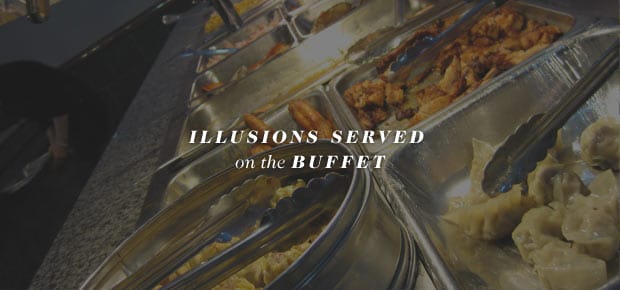I just got back from a stay at a Caribbean all-inclusive resort. As is typical for these resorts, people complained about the food quality at the buffets, preferring instead the resorts’ a la carte style restaurants. This widely held belief is not the result of any actual disparity in the food, but of several tricks played on our minds by the experience.
I’ve stayed at many of these resorts, and heard the same thing at all of them: the buffet food is mostly inedible, and the restaurant food is the only decent thing to eat. In fact, this belief is so universal that visitor reviews of the resorts carry this refrain consistently. The resorts even reinforce this illusion by touting a high number of restaurants (vs buffets) as a feature.
But the food served at each is really the same. At most resorts the food is prepared in the same kitchen, by the same cooks, with the same ingredients. Many of the restaurants are adjoined onto the buffets, though the architectural details may obscure this fact somewhat. Other restaurants serve as buffets during the day, often for breakfast or lunch.
There are three things at work that all contribute to the perceived disparity of quality:
Paradox of choice
The paradox of choice suggests that the more options presented to us, the less satisfied we’ll be with our choice.
So the buffet – with all of the single items on it that can then be combined in thousands (or millions) of ways – offers so much choice that we can’t be happy with our decision. No matter what we choose, we are always wondering if there wasn’t a better decision, a more satisfying combination.
Restaurants have a narrow range of options available to its patrons, as they operate with a price-fix five course format (soup, salad, appetizers, entree, dessert). At each stage of the meal there might be only one or two options, with the entree stage offering as many as eight options. But because the meal is broken up into stages with a comparatively small number of options at each sage, it’s easier to discriminate between each option. By forcing us focus our attention on mall decisions, we end up more confident in our choices.
Where the buffet challenges us with “what am I going to have for dinner” the restaurant makes it easier, “would I prefer tomato bisque or seafood chowder.”
Scarcity
While the buffets have a come as you please, no reservations required policy, the restaurants offer more of a challenge. Reservations are required, and are often made days in advance. Resorts may also limit the number of times you can visit the restaurants per week. The dress code at the restaurants is usually stricter than the buffet as well. All of this means that it’s more challenging to eat at the restaurants, it takes more work, more planning; and this builds in additional value to the experience. We feel it must be better, because it was harder to obtain.
Once you’re in, scarcity also plays a role with how we’re shown the food. At the buffet the food is piled high in long rows. Anything you could want to eat is there, enough to feed an army. But at the restaurant you only see the food you’re actually going to eat, and the portions are controlled for you. You see less, and so the food seems to be more scarce than at the buffet. That scarcity builds in even more value for the restaurants.
Presentation
“That looks gooood.” The way our food looks can greatly affect our receptions of it. If you look at any modern cookbook you will see gorgeous photos of elaborately presented food. This elaborate presentation doesn’t change how it tastes, but it makes the food look more appetizing.
Watch people at a buffet and you’ll see them take a plate and pile food onto it wherever it will fit, sometimes stacking additional food on top. It’s about as far from elegant as you can get. At the restaurant your food is plated. Your food s considered, it’s arrangement is designed to look appetizing. The food simply looks better.
There is one other reason that people hate the buffets: they get bored. Buffet patrons take more types of food than they normally would. The thinking as they move through the buffet is along the lines of “Does this look good? Yes, take some; no, move on.” So people end up with ten things on their plate instead of three. At the onset this isn’t a problem, but as this repeats itself over the week we end up eating the same meal multiple times. This isn’t the result of a mind-trick as it is poor planning on our part.
There’s not a lot that the resort can do to change this phenomenon, not without some pretty serious changes to how it operates. But I don’t think they want to change anything either – it would cost too much and be too risky for them.
I suppose a resort could try positioning itself as a culinary experience which – if executed properly – could offer a strong point of differentiation for the brand. I find the brand differentiation in this sector to be especially weak, so anything would help.
